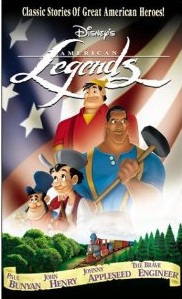Plot
In 1806, Pittsburgh farmer Johnny Appleseed watches as pioneers depart out west and wishes that he could follow, but doesn't know how to survive in the unknown wild. Johnny is inspired by an angel to abandon his farm, go west, and plant apple seeds everywhere he goes so that settlers will always have something to eat during their travels. The angel tells Johnny that he has all that he needs to go out West: a bag of apple seeds for planting, a holy book known as the Bible, and a tin pot he can use for a hat. In one of his travels, Johnny befriends a skunk, and thereafter, all animals instinctively trust him. As Johnny travels, he uses his pot to fry in, and sings a tune "The Lord Is Good to Me".
In the end, after walking hundreds of miles and planting apple trees all along the way, Johnny finally rests for the last time under a tree; his angel appears before him, and tells Johnny that it's time to go. Johnny's spirit gets up, scared at first upon realizing he's dead and is reluctant to go to his final resting place, believing that his work is not done yet. However, the angel tells him that, where they're headed, they're low on apple trees, so Johnny picks up his seed bag and happily agrees to go with him.
The narrator finishes by saying that he always thinks of Johnny Appleseed whenever he looks up because the clouds in the sky aren't really clouds at all: "They're apple blossoms, if you please, from John's heavenly orchard of apple trees".

Song of the South is a 1946 American live-action/animated musical drama film directed by Harve Foster and Wilfred Jackson; produced by Walt Disney and released by RKO Radio Pictures. It is based on the Uncle Remus stories as adapted by Joel Chandler Harris, and stars James Baskett as Uncle Remus in his final film role. The film takes place in the U.S. state of Georgia during the Reconstruction era, a period of American history after the end of the American Civil War and the abolition of slavery. The story follows seven-year-old Johnny who is visiting his grandmother's plantation for an extended stay. Johnny befriends Uncle Remus, an elderly worker on the plantation, and takes joy in hearing his tales about the adventures of Br'er Rabbit, Br'er Fox, and Br'er Bear. Johnny learns from the stories how to cope with the challenges he is experiencing while living on the plantation.

Johnny Appleseed was an American pioneer nurseryman who introduced apple trees to large parts of Pennsylvania, Ohio, Indiana, Illinois, and present-day Ontario, as well as the northern counties of present-day West Virginia. He became an American legend while still alive, due to his kind, generous ways, his leadership in conservation, and the symbolic importance he attributed to apples. He was also a missionary for The New Church (Swedenborgian) and the inspiration for many museums and historical sites such as the Johnny Appleseed Museum in Urbana, Ohio.

The Sword and the Rose is a family/adventure film produced by Perce Pearce and Walt Disney and directed by Ken Annakin. The film features the story of Mary Tudor, a younger sister of Henry VIII of England.
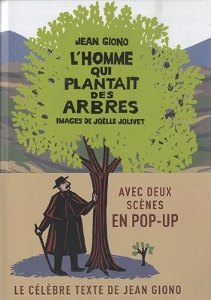
The Man Who Planted Trees, also known as The Story of Elzéard Bouffier, is an allegorical tale by French author Jean Giono, published in 1953. It tells the story of one shepherd's long and successful singlehanded effort to re-forest a desolate valley in the foothills of the Alps, near Provence, throughout the first half of the 20th century. It was written in French, and first published in English. The story has become known worldwide and is seen as an inspiration for ecological regeneration brought about by man. In 1988, Frédéric Back won an Academy Award for the animated short film The Man Who Planted Trees. The film was published in two versions, French and English, and narrated respectively by actors Philippe Noiret and Christopher Plummer.

Fun and Fancy Free is a 1947 American animated musical fantasy anthology film produced by Walt Disney and Ben Sharpsteen and released on September 27, 1947 by RKO Radio Pictures. The film is a compilation of two stories: Bongo, narrated by Dinah Shore and loosely based on the short story "Little Bear Bongo" by Sinclair Lewis; and Mickey and the Beanstalk, narrated by Edgar Bergen and based on the "Jack and the Beanstalk" fairy tale. Though the film is primarily animated, it also uses live-action segments starring Edgar Bergen to join its two stories.

Melody Time is a 1948 American live-action and animated musical anthology film produced by Walt Disney. It was released to theatres by RKO Radio Pictures on May 27, 1948. Made up of seven segments set to popular music and folk music, the film is, like Make Mine Music before it, the popular music version of Fantasia. Melody Time, while not meeting the artistic accomplishments of Fantasia, was mildly successful.
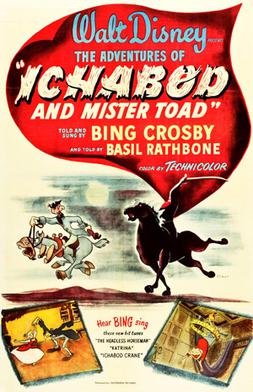
The Adventures of Ichabod and Mr. Toad is a 1949 American animated anthology film produced by Walt Disney Productions and released by RKO Radio Pictures. It consists of two segments: the first based on Kenneth Grahame's 1908 children's novel The Wind in the Willows and narrated by Basil Rathbone, and the second based on Washington Irving's 1820 short story The Legend of Sleepy Hollow and narrated by Bing Crosby. The production was supervised by Ben Sharpsteen, and was directed by Jack Kinney, Clyde Geronimi, and James Algar.
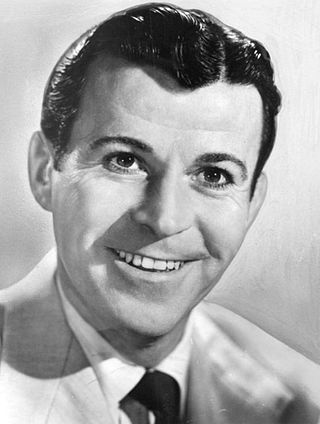
Dennis Day was an American actor, comedian and singer. He was of Irish descent.

Winnie the Pooh and the Blustery Day is a 1968 American animated featurette based on the third, fifth, ninth, and tenth chapters of Winnie-the-Pooh and the second, eighth, and ninth chapters from The House at Pooh Corner by A. A. Milne. The featurette was directed by Wolfgang Reitherman, produced by Walt Disney Productions and released by Buena Vista Distribution Company on December 20, 1968, being shown in theaters with The Horse in the Gray Flannel Suit. This was the second of the studio's Winnie the Pooh theatrical featurettes. It was later added as a segment to the 1977 film The Many Adventures of Winnie the Pooh. The music was written by Richard M. Sherman and Robert B. Sherman. It was notable for being the last Disney animated short to be produced by Walt Disney, who died of lung cancer on December 15, 1966, two years before its release.
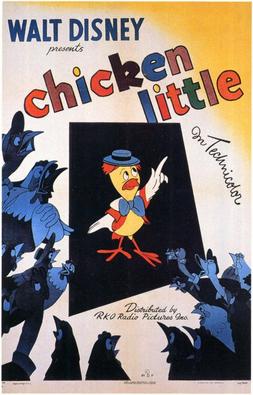
Chicken Little is a 1943 short film created by Walt Disney during World War II and directed by Clyde Geronimi. The short was based on the European folk tale "Henny Penny", known in the United States as "Chicken Little". It is an anti-Nazi film showing the evils of mass hysteria.

Johnny Tremain is a 1957 American adventure drama film made by Walt Disney Productions, released by Buena Vista Distribution, and based on the 1944 Newbery Medal-winning children's novel of the same name by Esther Forbes, retelling the story of the years in Boston, Massachusetts prior to the outbreak of the American Revolution. Johnny Tremain was the first Disney live-action film to be directed by Robert Stevenson. It was made for television but was first released in theatres. Walt Disney understood the new technology of color television and filmed his Walt Disney anthology television series in color. But the show, known as Disneyland at that time, was broadcast in black and white. After its theater run in 1957, the film was shown in its entirety on television in two episodes, rather than as a complete film on a single evening, on November 21 and 28, 1958.

The Reluctant Dragon is a 1941 American live-action/animated anthology comedy film produced by Walt Disney, directed by Alfred Werker, and released by RKO Radio Pictures on June 27, 1941. Essentially a tour of the then-new Walt Disney Studios facility in Burbank, California, the film stars Algonquin Round Table member, film actor, writer and comedian Robert Benchley and many Disney staffers such as Ward Kimball, Fred Moore, Norman Ferguson, Clarence Nash, and Walt Disney, all as themselves.

The origins of the Rambo apple cultivar are unknown. It may date back to the American colony of New Sweden, when in 1637 Peter Gunnarsson Rambo, a Swedish immigrant, arrived on the Kalmar Nyckel. Swedish natural historian Pehr Kalm, who wrote Travels in North America, 1747–51, took notes of his interview with Mr. Peter Rambo, grandson of Peter Gunnarsson Rambo, recording that the "original Peter Rambo had brought apple seeds and several other tree and garden seeds with him in a box." The first Rambo apple tree was very likely grown from one of these seeds. There is no certainty, however, since the earliest documented mention of the apple variety's origin occurs in William Coxe's A View of the Cultivation of Fruit Trees, and the Management of Orchards and Cider, published in 1817. Coxe wrote only that the Rambo was much cultivated in Delaware, Pennsylvania, and New Jersey and took "its name from the families by whom it was introduced into notice."
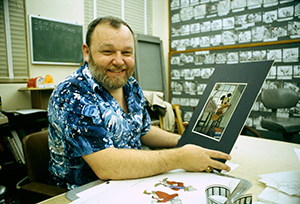
Burnett Mattinson was an American animator, director, producer, and story artist for Walt Disney Animation Studios, where he was employed from 1953 until his death in 2023.
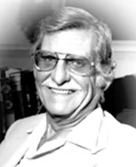
Winston Murray Hunt Hibler was an American screenwriter, film producer, director and narrator associated with Walt Disney Studios.

Disney's American Legends is a 2002 American animated anthology film narrated by James Earl Jones. It is a compilation of four previously released animated musical shorts from Walt Disney Animation Studios based on American tall tales. The film features The Brave Engineer (1950), Paul Bunyan (1958), John Henry (2000), and The Legend of Johnny Appleseed which is a segment from the 1948 film Melody Time.

Ferdinand the Bull is a 1938 American stand-alone animated short produced by Walt Disney Productions and released on November 25, 1938, by RKO Radio Pictures. It was directed by Dick Rickard and based on the 1936 book The Story of Ferdinand by Munro Leaf. The music was by Albert Hay Malotte, most known for his setting of The Lord's Prayer, commonly sung at weddings.

Pluto's Christmas Tree is a 1952 Mickey Mouse cartoon in which Pluto and Mickey cut down a Christmas tree that Chip n' Dale live in. It was the 125th short in the Mickey Mouse film series to be released, and the second for that year. While the chipmunks are usually antagonists of Donald Duck, they have pestered Pluto before, in Private Pluto (1943), Squatter's Rights (1946) and Food for Feudin' (1950).
Ruth Irene Tompson was an American camera technician, animation checker and supercentenarian. She was known for her work on animated features at The Walt Disney Company and was declared a Disney Legend in 2000.

Soup's On is a 1948 Donald Duck animated short film directed by Jack Hannah, produced in Technicolor by Walt Disney Productions and released to theaters by RKO Radio Pictures.
